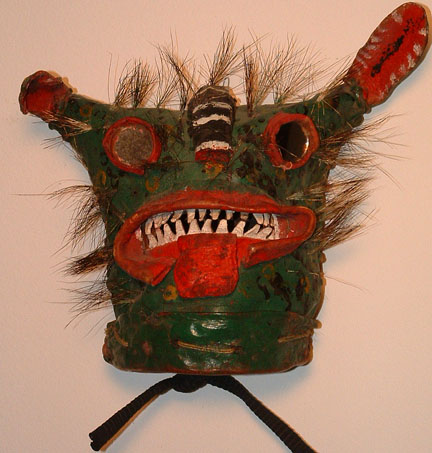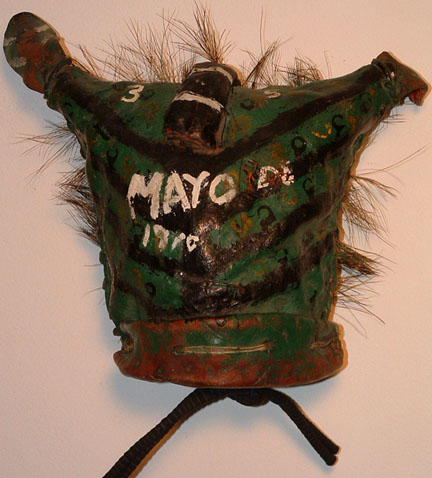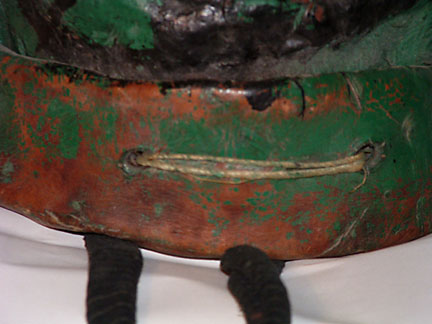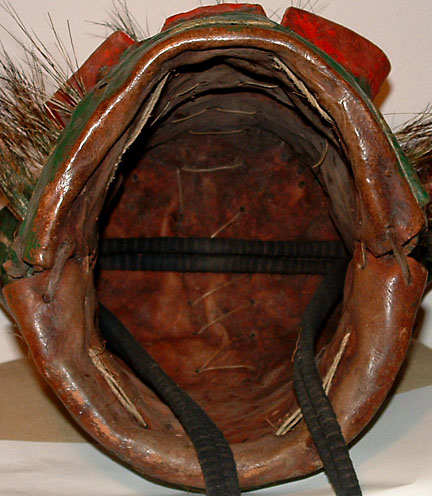
Mask of the Month #3Tiger/Jaguar Mask
Region of Zitlala, Guerrero
Painted leather, animal bristles, mirrors
Whatever
ye have come fer
Best ye listen to what I say
A fine Zitlala tiger, sir
Will seldom come yer way
So if ye craves this feline face
and hopes to have one soon
Then best ye first be learnin'
to sit howlin' at the moon
Old Irish limerick, origin unknown

Approx. age: 50 years
It is indeed rare to find an exemplary Zitlala tiger; one which was produced
and used in its rightful cultural/ethnic context; one of good craftsmanship,
age and patina; and, most importantly, one which was not created solely
for the purpose of sale. Over the last half-century (or more,) the violent
Dance of the Green and Yellow Tigers has attracted the attention of cultural
anthropologists and ethnographers. As articles appeared in magazines and/or
journals, the best of these remarkable masks from the region of Zitlala,
Guerrero were no doubt acquired by dealers and collectors long ago.
Then, as is so often the case when an item meets with such strong interest, the market became inundated with Zitlala tiger replicas by the hundreds, if not thousands - and their sale to tourists and amateur collectors continues to this day. It was even rumored that the infamous Hunt brothers of Texas tried to corner the market in the tigers before turning to silver in the late 70's, but I avoid letting this sort of gossip distract me from more serious study.

Rear View
 |
 |
|
Bottom
Cuff
|
Bottom
View
|
ZITLALA TIGER TIPS
As with any decent pair of trousers, the bottom cuff is an important element. A thick cuff should be carefully stiched around the base of the mask and have authentic wear and patina at the edges (see photos). Zitlala tigers are reportedly soaked in water to soften the leather prior to their use. That might explain why I have never seen a Zitlala tiger that would fit a normal man's head; so I accept that either they have shrunk to an unwearable size after being soaked - or that the men of Zitlala have very small heads.
Keep in mind the various techniques which may be used to make these tigers look older and "more used" than they really are. Caveat emptor is the rule for prospective buyers. Deliberate abuse and chemical blistering of the paint can cause a suspicious uniformity in the surface texture - real aging does not usually occur this way. However, one should also consider that a tiger mask may have been soaked in water, which may have affected the paint.
Whatever the true history of these strange helmet masks is, one cannot ignore that such a pronounced flooding of the market has stamped a questionable provenance on most all masks of this type. A lamentable consequence of popularity - like Pachelbel's Canon or Ravel's Bolero, they've simply been overplayed.
Note: If you are ever in Zitlala, bored and looking for something different to do, click here.
© 2005 www.mexicanmasks.us - All Rights Reserved